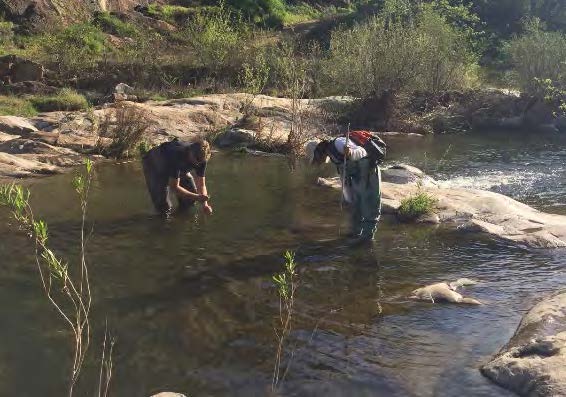DNA-based methods for identifying algae shown to be reliable, possibly more insightful

SCCWRP and its partners have shown in a proof-of-concept study that using DNA methods to conduct algae-based assessments of stream health offers a reliable, cost-effective alternative to traditional biological assessment methods and has the potential to provide richer insights into stream condition.
The three-year study, which will wrap up in February, compared traditional, morphology-based identifications of stream algae to DNA-based, or molecular, identifications of the same samples. Researchers showed that both methods could consistently distinguish among stream sites in poor vs. good ecological health.
The molecular approach, meanwhile, was able to identify hundreds more algal taxa than traditional microscopy-based taxonomic identification, underscoring its potential to provide a more detailed, nuanced understanding of the ecological condition of algal communities in wadeable streams.
Finally, the molecular approach provided more consistent results more rapidly and more cost-effectively than traditional microscopy.
Stream managers rely on algal communities as a key indicator of ecological impacts to streams because of their sensitivity to even small environmental changes. For example, the Algal Stream Condition Index – an algae-based stream condition scoring tool co-developed by SCCWRP and unveiled in 2019 – is expected to help form the technical foundation for a proposed statewide stream biointegrity-biostimulatory policy.
Even so, algae-based assessments have traditionally been dependent on a limited number of trained taxonomists to identify samples under a microscope. This manual identification process is costly, labor-intensive and prone to bottlenecks, underscoring the value of pursuing alternative, DNA-based approaches.
Over the past few sampling seasons, SCCWRP has partnered with stream bioassessment monitoring programs across California to collect and process stream algae samples using both traditional microscopy and molecular methods.
Based on the study’s findings, researchers already have begun tackling priority next steps that will enable managers to begin using the molecular methods for routine algae-based bioassessment work.
In particular, researchers have begun exploring the possibility that existing algae-based scoring tools may need to be recalibrated.
Furthermore, because molecular methods are able to identify more algal taxa than traditional methods, researchers have begun working to develop more robust assessment tools to take advantage of the additional data.
Researchers already have begun a follow-up study exploring how to build more global DNA reference libraries to identify additional key algal taxa in California streams.
SCCWRP is working closely with the California Molecular Methods Workgroup – a technical workgroup of the California Water Quality Monitoring Council – to ensure the study’s findings are used to inform standardized sampling and analytical protocol development.
A final study report is expected to be published this spring.
For more information, contact Dr. Susanna Theroux.
More news related to: Bioassessment, DNA Barcoding, Indices of Biotic Integrity, Top News